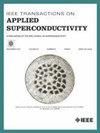Equivalent Circuit Extraction of MI-HTS Coil Including High-Frequency Region for Electromagnetic Transient Simulation With Voltage-Source Converter
IF 1.8
3区 物理与天体物理
Q3 ENGINEERING, ELECTRICAL & ELECTRONIC
引用次数: 0
Abstract
Combining metal-insulation high-temperature superconductor (MI-HTS), power electronics presents a promising potential to implement reliable magnetic energy storage systems. A modern power converter, typically implemented as a voltage-source converter (VSC), utilizes power semiconductors with switching frequencies ranging from several kHz to hundreds of kHz. From a VSC design perspective, analyzing the current flowing into power semiconductors at the microsecond timescale is essential to prevent converter failure due to overcurrent. Thus, to reduce the risk of operation failure of VSC, it is crucial to simulate the operation of VSC with MI-HTS not only the long-term behavior but also the short-term dynamics before commissioning. This article presents a practical method to develop an equivalent circuit of MI-HTS, enabling the replication of its current response at the microsecond timescale within electromagnetic transient simulations. This circuit can be used to verify the operation of MI-HTS and VSC, including control algorithms, by considering characteristics of leakage currents in MI-HTS under pulsed voltage from the VSC. The proposed method utilizes measured frequency response data and a rational approximation algorithm to extract an equivalent circuit. The proposed procedure is validated through a comparison of simulated and experimental results from closed-loop current control of a 37.2 mH MI-HTS coil driven by a VSC with a switching frequency of 2 kHz.电压源变换器电磁瞬态仿真中含高频区域的MI-HTS线圈等效电路提取
结合金属绝缘高温超导体(MI-HTS),电力电子学在实现可靠的磁储能系统方面具有广阔的潜力。现代功率转换器,通常作为电压源转换器(VSC)实现,利用开关频率从几kHz到数百kHz的功率半导体。从VSC设计的角度来看,在微秒时间尺度上分析流入功率半导体的电流对于防止转换器因过流而失效至关重要。因此,为了降低VSC运行失败的风险,在调试前用MI-HTS模拟VSC的长期行为和短期动态是至关重要的。本文提出了一种实用的方法来开发MI-HTS的等效电路,使其在微秒时间尺度上的电流响应能够在电磁瞬变模拟中复制。该电路可用于验证MI-HTS和VSC的运行,包括控制算法,通过考虑MI-HTS在VSC脉冲电压下的漏电流特性。该方法利用实测频响数据和合理逼近算法提取等效电路。通过对开关频率为2khz的VSC驱动的37.2 mH MI-HTS线圈的闭环电流控制的仿真结果和实验结果的比较,验证了所提出的程序。
本文章由计算机程序翻译,如有差异,请以英文原文为准。
求助全文
约1分钟内获得全文
求助全文
来源期刊

IEEE Transactions on Applied Superconductivity
工程技术-工程:电子与电气
CiteScore
3.50
自引率
33.30%
发文量
650
审稿时长
2.3 months
期刊介绍:
IEEE Transactions on Applied Superconductivity (TAS) contains articles on the applications of superconductivity and other relevant technology. Electronic applications include analog and digital circuits employing thin films and active devices such as Josephson junctions. Large scale applications include magnets for power applications such as motors and generators, for magnetic resonance, for accelerators, and cable applications such as power transmission.
 求助内容:
求助内容: 应助结果提醒方式:
应助结果提醒方式:


